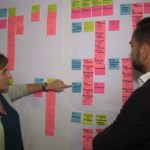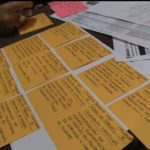Scrum, agile... BBVA’s new ways of working to accelerate its transformation
BBVA’s transformation process involves a new corporate culture with new, more agile and flexible ways of working. We spent two days in one of the quarterly planning sessions BBVA is holding around the world to find out firsthand what this new way of working is like.

Scrum, agile, scrum master, product owner… these are words that are common in the software development world, but unknown to a novice. They are concepts used in agile work methodologies that emerged in the mid-1980s and early 1990s, coinciding with rise of consumer computing.
Transformation requires a change in culture
Over the past two years, in order to accelerate its transformation, BBVA has been taking steps to adopt a new corporate culture with new ways of working based on agile methodologies. “The Group needs a cultural change in order to accelerate the implementation of transformation projects. It means moving away from rigid organizational and functional structures toward a much more collaborative way of working", explains Antonio Bravo, BBVA’s Head of Strategy & Planning for Business Development Growth Markets. “The main goal is to increase the speed and quality of execution.”
"It means moving away from rigid organizational and functional structures toward a much more collaborative way of working
BBVA began forming the first scrum in 2014, one of the best known agile working methodologies. Scrums are multi-disciplinary, autonomous teams of eight to 12 people who work together to accomplish a common goal (normally a software development, but sometimes other goals that are not software related) with short iterations.

BBVA employees work with agile methodologies in the Group's headquarters in Las Tablas (Madrid). - BBVA
In other words, the teams work simultaneously and with tight deadlines, every two or three weeks, which makes it possible to verify with customers that they are working in the right direction. “It allows us to be more agile and flexible when creating the developments,” explains Héctor Borreguero the head of Agile at BBVA’s Business Process Engineering Area.
The BBVA Group currently has more than 150 scrums, and more than 1,000 people around the world working with this methodology. But it’s a big challenge because BBVA is not a startup with 20 employees. “BBVA is a large bank with many teams and people who work together and interrelate to carry out projects. Managing this joint effort, as well as aligning and coordinating the work of the different teams is a very significant challenge that is critical to improve execution capacity,” maintains Antonio Bravo.
The benefits of scrum are not just for the scrum teams
Obviously the whole bank cannot work in scrum mode, but over the past two years, the teams in charge of introducing new ways of working in the bank are incorporating many of the benefits and concepts from the agile methodologies in the other projects and teams. “What we have learned is that there is no way to integrate traditional work methodologies and agile methodologies – not with two or three week iterations like the scrums - but it is possible with three month iterations,” indicates Héctor Borreguero. This is the rationale for the quarterly planning session.

BBVA Continental headquarters in Lima, Perú. - BBVA Continental
In mid-June 2016 we went to Lima, where BBVA Continental, the Group’s bank in Peru, will hold its second quarterly planning session. Two intense days of work await us with 150 people gathered in a room at a centrally-located hotel.
"This creates commitment and collaborative work - team work like I have never seen before in the years I have worked for the organization.
“These quarterly planning sessions are the summum of this great cultural transformation. You can see multidisciplinary teams sitting in a relatively large space, where people from all areas participate,” says Samuel Sánchez, BBVA Continental’s Digital Banking Manager. “This creates commitment and collaborative work - team work like I have never seen before in the years I have worked for the organization.”
Quarterly planning begins
The first thing you notice is that the room’s four walls are covered with paper - large pieces of blank paper with the names of projects or teams at the top: payment systems, digital channels, customer relations, mutual funds, etc. Long tables with markers and multicolored post-its lie in front of the papers.
Eduardo Torres-Llosa, CEO at BBVA Continental, opens the session. “This new way of doing things through a quarterly planning session represents a very significant, and highly relevant change for our organization,” he explains. “It is giving us much greater speed, execution capacity and therefore, is separating us from the competition in something so important as offering our customers products and services in a much more rapid and agile manner.”

Eduardo Torres-Llosa, CEO at BBVA Continental. - BBVA
The session began with an overview of all the projects planned three months ago: many have now become a reality. Of the 57 projects planned at the time, 44 were successful, as planned, and 31 are now in customers’ hands.
“We were really impressed by the team’s quality and delivery capacity,” affirms Orlando Lay Ma, Digital Banking Release Train Engineer at BBVA Continental.
For instance, BBVA Continental is working on a project to open accounts online - something totally new in Peru - and another project to incorporate mobile tools in offices that help executives with customers.
“They are two fairly clear examples of what we are looking for in this planning,” notes Milo Dragañac, Manager of the Digital Solutions Factory and Program Management at BBVA Continental. “All areas of the bank are going to focus on a single priority, or on several, to be able to have results in one quarter – results that can be delivered to internal or external customers,” he explains.
“Quarterly planning gives us a clear vision of what will be done over the next three months in a coordinated and organized manner

An employee during the second quarterly planning of BBVA Continental in Lima (Peru) in June 2016. - BBVA
The four stages of planning
After the overview, planning for the next three months begins. Quarterly planning consists of four stages:
- Identify the portfolio of projects for the quarter;
- Prioritize the projects according to their strategic importance;
- Identify the projects’ dependencies, either on other projects or other support or monitoring areas; and
- Identify the resources available for all these initiatives.
“Quarterly planning gives us a clear vision of what will be done over the next three months in a coordinated and organized manner,” explains Luis Cembrero, Head of Portfolio Management in Business Development Growth Markets.
The different teams in the room meet and start planning. The papers on the wall that used to be blank start to fill with colored post-its covered with notes.

“The color coding is very simple but imperative”
What are the post-its for?
In this planning session, the colors have the following meaning:
Blue post-its are used to define each project’s objectives;
Yellow post-its are used to identify the tasks that contribute to this objective;
Pink post-its are used to identify each of these tasks’ dependencies on support or monitoring areas, or on another project; and
Orange post-its are used to tell these support and monitoring areas the task they need to carry out.
Post-its make it possible to see in a very visual manner that the teams are working and properly structuring the requirements in different levels. “More than anything, it lets us see how the dependencies are being managed, what I have to do and what others have to do for me,” explains Héctor Borreguero. “The color coding is very simple but imperative.”

Employees of BBVA Continental during the quarterly planning. - BBVA
Second day: negotiation time
The second day begins. On the first day, the teams identified the projects to be carried out over the next three months, prioritized each of them and determined what they need from other teams and other projects to accomplish their objective.
On the second day, teams negotiate these tasks with other teams and projects so that they become commitments. “They have to determine if they will be able to do everything being asked of them given the amount of time and resources available", explains Luis Cembrero.
“This day saves us a lot of time in meetings, and emailing back and forth,” affirms Ana Karina Cáceres, participant in the planning from the BBVA Asset Management Peru team. “Being all in the same place allows us to start to commit people ahead of time.”
“They have to determine if they will be able to do everything being asked of them given the amount of time and resources available

"People are really excited with these new methodologies"
For Gonzalo Camargo, Director of Business Development at BBVA Continental, the new ways of working have really turned things around in the bank: “The responsibility we always used to attribute to the Media area, or to Technology of ‘hey, you’re not doing what I asked', has now changed because the scrums have demonstrated that they have an incredible execution capacity. And now the pressure is on business, my area, because we are the ones that have to do what is asked to move the bank forward in its transformation.”
The day ends and the projects and commitments to be fulfilled over the next three months are reflected on a sea of colored post-its.
“People are really excited,” maintains Karina Bruce, Talent and Culture Manager at BBVA Continental. “They want to find out what else lies behind the agile model. They want to participate in the scrum. I think these new ways of working are definitely creating a lot of commitment.”
“It’s my first time participating and I was imagining something much less interactive and a slower pace,” says Patricia Gutiérrez, from Continental Bolsa SAB team.

Orange post-its are used to tell these support and monitoring areas the task they need to carry out. - BBVA
From skepticism to conversion
After seeing the results of the first planning session, the teams have gone from being somewhat skeptical to really valuing these work methods because of their results. Quarterly planning sessions have already started in Spain, Mexico, Argentina, Chile, Colombia, Peru and Venezuela and are expected to start in Turkey at the end of 2016.
“I must confess that I was skeptical about the scrums and the agile methodologies, especially in terms of massive planning,” affirms Eduardo Torres-Llosa. “But the truth is that it is producing high levels of motivation and above all, greater efficiency - getting several people to agree on highly specific issues. I have to admit that I am a convert of these methodologies.”

"I was skeptical, but now I have to admit that I am a convert of these methodologies"